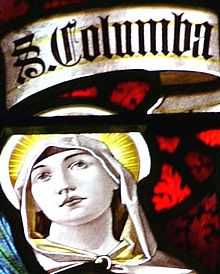Columba the Virgin
| Saint Columba the Virgin | |
|---|---|
 From stained glass window at St. Columb Major church | |
| Virgin & Martyr | |
| Born |
very late 5th century possibly Lothian, Scotland probably |
| Died |
6th century Ruthvoes, Cornwall |
| Honored in | Roman Catholicism; Anglican Communion |
| Major shrine | St Columb Major |
| Feast | 11 November/15 November |
| Attributes | female carrying a palm branch and a sword, a dove hovering above |
- See Columba (disambiguation) and St Columb for other uses.
Saint Columba the Virgin is a female saint with dedications in Cornwall and other Celtic regions. She probably lived in the 6th century.
She became a Christian when the Holy Ghost appeared to her in the form of a dove. The Latin word for dove is 'columba'.
The Legend
The legend of Saint Columba, the Virgin, is recorded in a manuscript in the University Library of Cambridge, written by Nicholas Roscarrock in the reign of Elizabeth I and he says he gathered it from local information.
This states that Columba was the daughter of King Lodan and Queen Manigild, both pagans, and that to escape marriage with another pagan prince she took ship for Cornwall and was followed by the prince. She landed at Trevelgue Head and was chased through the forest which is now Porth Beach, and fled up the valley, past Rialton and Treloy until she was captured at Ruthvoes, two miles south of St Columb Major. There the prince cut off her head, and where the blood fell a spring gushed forth and the water following the course of her flight made the still unnamed river which empties itself at St Columb Porth.
Analysis
This legend bears many parallels with the legend of Saint Columba of Sens and the Greek legend of Arethusa a nereid (a water nymph). Arethusa, like Columba was a maiden, she preferred to remain chaste. During the course of her adventures, she decided to take a dip in the welcoming water. But as soon as she entered the river, she realized that she was not alone. For the god of this particular river (who was named Alpheus) was roused by the sight of Arethusa, and immediately fell in love with the nymph. Arethusa fled the advances of Alpheus. However, Alpheus was not so easily deterred - the god of the river simply assumed the form of a hunter and pursued his chosen prey. Some versions of the story say that Arethusa was chased over the sea, all the way to Sicily. Finally, she found refuge on the Island of Ortygia (which is near Syracuse), where she called upon the goddess Artemis to rescue her. Artemis responded by transforming the nymph into a spring or fountain. And this is how the nymph Arethusa became identified with a now legendary spring.
Columba is a popular Irish name and Sabine Baring-Gould thought she was really a man. David Nash Ford suggests her parents, Lodan and Manigild, are corrupt forms of Lot and Morgause of Arthurian legend.
Veneration
Dedications to Saint Columba the Virgin include:
- St Columb Major, Cornwall
- St Columb Minor, Cornwall
- Culbone, Somerset
and originally:
- Plougoulm, Brittany
In St Columb Major and Minor, her feast day is on 11 and 15 November respectively.
See also
The following Celtic saints have similar legends in that they were all maidens who were pursued and killed by pagans. All suffer decapitation where springs or wells then miraculously gushed forth from the spot.
- Saint Columba of France
- Saint Columba of Spain
- Saint Eluned of Wales
- Saint Urith of Chittlehampton, Devon
- Saint Winefride of Flintshire in Wales
For a variation of the beheading legend see Saint Decuman